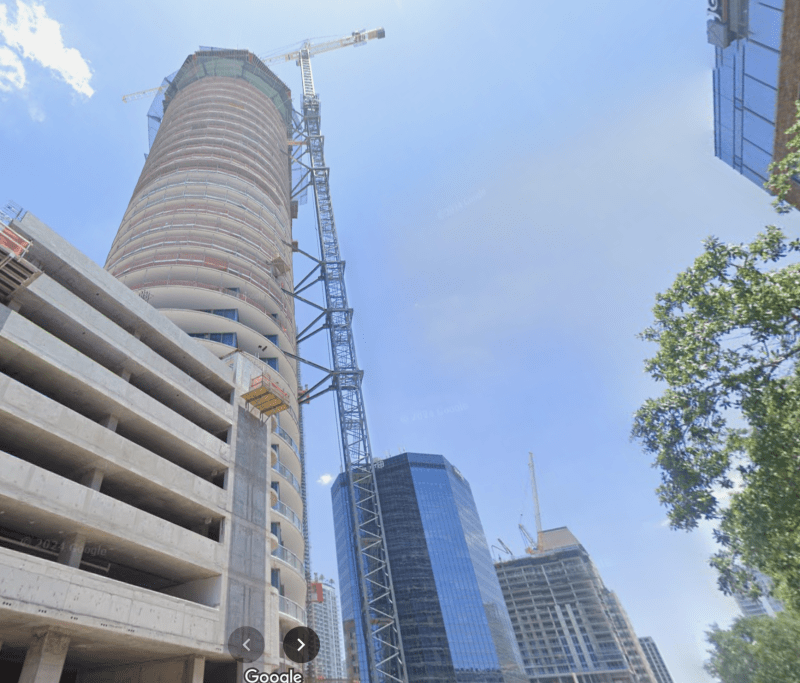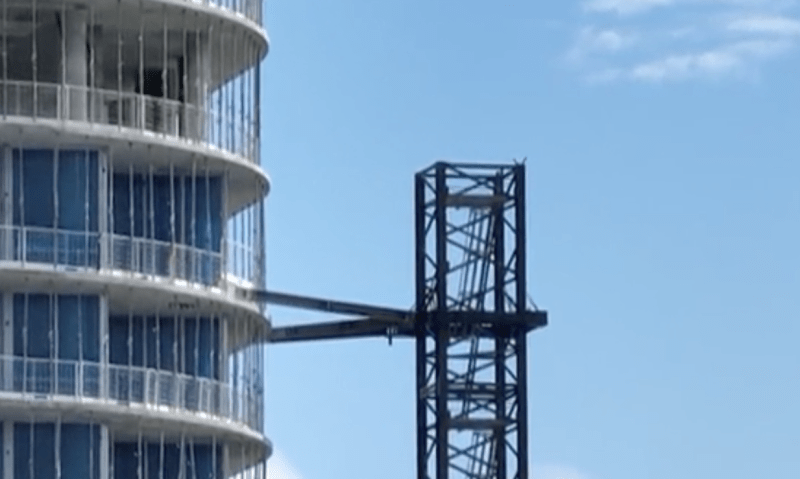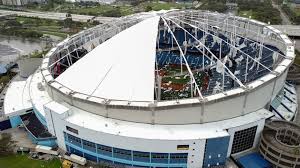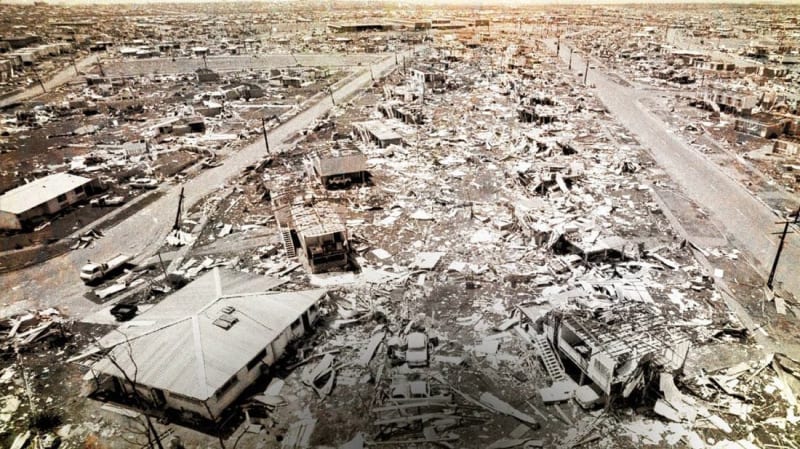Navigation
Install the app
How to install the app on iOS
Follow along with the video below to see how to install our site as a web app on your home screen.
Note: This feature may not be available in some browsers.
More options
Style variation
-
Congratulations cowski on being selected by the Eng-Tips community for having the most helpful posts in the forums last week. Way to Go!
You are using an out of date browser. It may not display this or other websites correctly.
You should upgrade or use an alternative browser.
You should upgrade or use an alternative browser.
Milton Crane Collapses
- Thread starter XR250
- Start date
- Status
- Not open for further replies.
The crane seems to have had significant bracing, if not interesting.

Google Maps (dated May 2024)
It seems like a clean break at a tower section connection with one or more braces letting go above.


Raw video footage from WAFF 48

Google Maps (dated May 2024)
It seems like a clean break at a tower section connection with one or more braces letting go above.


Raw video footage from WAFF 48
Maybe off-topic, but it is reported the roof of the Tropicana stadium was designed to withstand 115 mph winds, although the NWS reports the highest gust measured in St. Pete was 101 mph:

Downdraft/local variability? Defective Installation? or Engineering Failure?

Downdraft/local variability? Defective Installation? or Engineering Failure?
JohnRBaker
Mechanical
Since the covering of the rook was canvas I suspect that the statement that it could withstand 115 mph wind was respect to the structural members holding up the roofing material, as it looks like it did pretty well. In fact, when I read that the roof itself was made of canvas I figured that it was sacrificial, that is it was designed to tearaway without taking the roof structure with it. The cost of replacing a canvas roof every couple of years wouldn't be all that much compared to having to replace the structure itself. Besides, in that climate with the heat, rain and hot Sun, that canvas roof had to have been an expendable from the beginning.
John R. Baker, P.E. (ret)
Irvine, CA
Siemens PLM:
The secret of life is not finding someone to live with
It's finding someone you can't live without
John R. Baker, P.E. (ret)
Irvine, CA
Siemens PLM:
The secret of life is not finding someone to live with
It's finding someone you can't live without
Apparently it was to be used as an emergency response staging area. It would be nice if the umbrella stayed up.
There is the difficulty of measuring wind speed close to the ground without being swamped by radar return clutter, so what was reported was only the maximum of what was measured and may not be the maximum everywhere.
Wear and tear on the material might have degraded it (see quote below) or the designers didn't run an analysis that coincided with every possible wind direction or some other factor, like having a door open and allowing the stagnation pressure build up inside and combining with the drop from dynamic pressure outside.
A very common way to turn a house from withstanding a hurricane to becoming yard waste is to have a wind-side window break and the whole house disintegrates like a latex balloon. Just have a branch or piece of lumber get picked up and, at 100mph, the glass window becomes a hole. Garage doors failing is the other popular choice.
My bolding. From
There is the difficulty of measuring wind speed close to the ground without being swamped by radar return clutter, so what was reported was only the maximum of what was measured and may not be the maximum everywhere.
Wear and tear on the material might have degraded it (see quote below) or the designers didn't run an analysis that coincided with every possible wind direction or some other factor, like having a door open and allowing the stagnation pressure build up inside and combining with the drop from dynamic pressure outside.
A very common way to turn a house from withstanding a hurricane to becoming yard waste is to have a wind-side window break and the whole house disintegrates like a latex balloon. Just have a branch or piece of lumber get picked up and, at 100mph, the glass window becomes a hole. Garage doors failing is the other popular choice.
One of the most striking moments of Milton came when the roof of Tropicana Field, home of MLB's Tampa Bay Rays, was torn off. The 34-year-old stadium was scheduled to be torn down as the Rays plan to move to a new stadium next door in 2028, but the next three years of the stadium are now in question after the roof's downfall.
My bolding. From
Surely houses should be designed for that very predicable event in a hurricane zone? That seems like an awfully big failure of design codes to me. For cyclone codes down here the code works on the assumption that windside holes will occur.3DDave said:A very common way to turn a house from withstanding a hurricane to becoming yard waste is to have a wind-side window break and the whole house disintegrates like a latex balloon. Just have a branch or piece of lumber get picked up and, at 100mph, the glass window becomes a hole. Garage doors failing is the other popular choice.
Cyclone Tracy almost 50 years ago taught us that lesson.

I think one of the news items I saw said that the stadium roof was cable and fiberglass.
I guess the big question, if the roof was "expendable", was everything inside that stadium designed to be weathertight, or was there a whole bunch of "indoor" stuff that all got dumped upon?
We had a pretty good little windstorm blow through a few months ago that damaged a lot of trees. But one thing it did was put a kink right in the middle of my garage door, so I had to have it replaced. It didn't fail in the sense of being removed, but was no longer operable.
I guess the big question, if the roof was "expendable", was everything inside that stadium designed to be weathertight, or was there a whole bunch of "indoor" stuff that all got dumped upon?
We had a pretty good little windstorm blow through a few months ago that damaged a lot of trees. But one thing it did was put a kink right in the middle of my garage door, so I had to have it replaced. It didn't fail in the sense of being removed, but was no longer operable.
EdStainless
Materials
Considering that large scale development began in the early 1920's there is quite a range of structures.
Many of the old ones are very good (except for windows and doors) because they were very scared of storms.
By the 1950's fast and cheap was the order of the day.
So you get a bit of everything.
If you have an old house and put good windows and doors into it you have a very solid house.
= = = = = = = = = = = = = = = = = = = =
P.E. Metallurgy, consulting work welcomed
Many of the old ones are very good (except for windows and doors) because they were very scared of storms.
By the 1950's fast and cheap was the order of the day.
So you get a bit of everything.
If you have an old house and put good windows and doors into it you have a very solid house.
= = = = = = = = = = = = = = = = = = = =
P.E. Metallurgy, consulting work welcomed
human909 - yes, New structures built in hurricane prone regions are required to have protected openings. That could be shutters, hurricane rated windows, etc.
As for Tropicana Field, it could also be age. Not sure about replacement canvas - I don't recall it ever being done but I also haven't lived there for some time. One reason it's considered one of the worst stadiums in the MLB is because it didn't start life as a baseball stadium. I went to arena football and Lightning hockey games there as a kid. And I think it had a life as something else before that.
As for Tropicana Field, it could also be age. Not sure about replacement canvas - I don't recall it ever being done but I also haven't lived there for some time. One reason it's considered one of the worst stadiums in the MLB is because it didn't start life as a baseball stadium. I went to arena football and Lightning hockey games there as a kid. And I think it had a life as something else before that.
SWComposites
Aerospace
Hockey games in a canvas roofed stadium in FL??? Seriously?
SW - yep. 1993 to 1996 or so. It was called the Thunder Dome then.
A little quick research - apparently I was wrong. It was built as a speculative baseball stadium, but nobody took the bait to relocate there so the leased it to the Storm and the Lightning. After several years, they finally got one of the new teams when the MLB expanded (adding the, then, Devil Rays and the Diamondbacks).
A little quick research - apparently I was wrong. It was built as a speculative baseball stadium, but nobody took the bait to relocate there so the leased it to the Storm and the Lightning. After several years, they finally got one of the new teams when the MLB expanded (adding the, then, Devil Rays and the Diamondbacks).
I'm guessing that in a state where the government has been mandated to deny or even mention climate change, any notion that building codes are inadequate is likely to be viewed as a concession to climate change.
TTFN (ta ta for now)
I can do absolutely anything. I'm an expert! faq731-376 forum1529 Entire Forum list
TTFN (ta ta for now)
I can do absolutely anything. I'm an expert! faq731-376 forum1529 Entire Forum list
IRstuff- you might think so, but no. While it's unlikely that they'll make any proactive attempts to improve the codes for forecasted conditions, they are pretty pragmatic about updating things based on past conditions. They take hurricanes very seriously.
That said, the building codes are already fairly robust. Note I'm not talking about implementation or enforcement - if followed, the building codes would have been sufficient for the wind event. The problem is prediction of and design for reliability in flooding conditions that were seen. Pushing for assessment and retrofitting of older structures in areas that haven't experienced an event to 'cull' the old building stock would also be prudent.
That said, the building codes are already fairly robust. Note I'm not talking about implementation or enforcement - if followed, the building codes would have been sufficient for the wind event. The problem is prediction of and design for reliability in flooding conditions that were seen. Pushing for assessment and retrofitting of older structures in areas that haven't experienced an event to 'cull' the old building stock would also be prudent.
I notice nobody actually answered the original question, so I was googling around a bit.
I did find these rather general items of interest:
Also, I find this statement:
"ISO 8686-3:2018 establishes load and load combination design principles of tower cranes, considering...out-of-service wind...",
On this page: So short answer, the hurricane condition is a design consideration that should have been considered. As to what actually led to the failure, I have no clue.
I did find these rather general items of interest:
Also, I find this statement:
"ISO 8686-3:2018 establishes load and load combination design principles of tower cranes, considering...out-of-service wind...",
On this page: So short answer, the hurricane condition is a design consideration that should have been considered. As to what actually led to the failure, I have no clue.
The other crane on the same building was still standing, so perhaps it was just local acceleration from the wind passing over the building that exceeded the ability or the free swiveling to weather vane didn't. Looks like a clean break, no large amount of twisted metal dangling. Maybe updraft pried it off?
- Status
- Not open for further replies.
Similar threads
- Locked
- Question
- Replies
- 4
- Views
- 5K
- Locked
- Question
- Replies
- 69
- Views
- 4K
- Locked
- News
- Replies
- 1
- Views
- 348
- Locked
- News
- Replies
- 7
- Views
- 688
- Replies
- 20
- Views
- 1K
